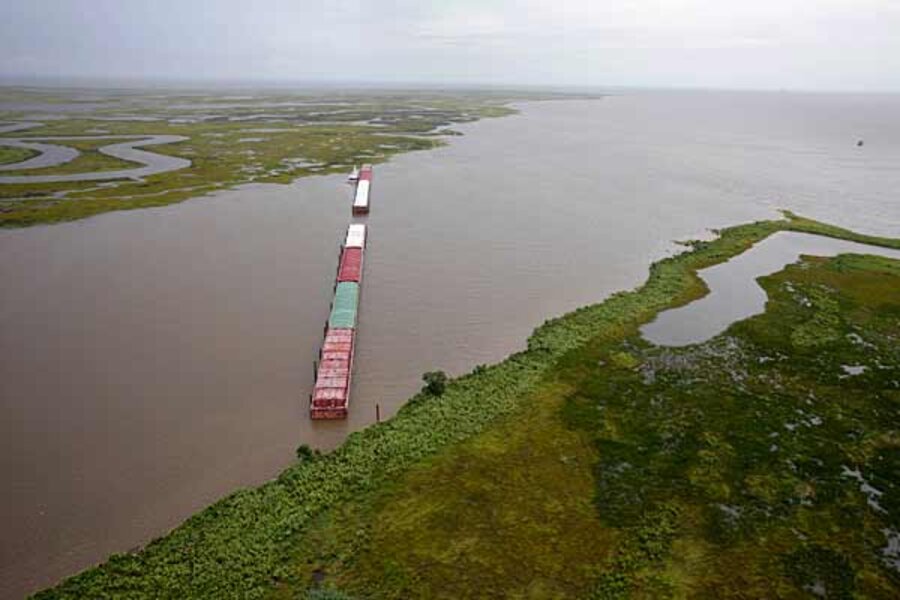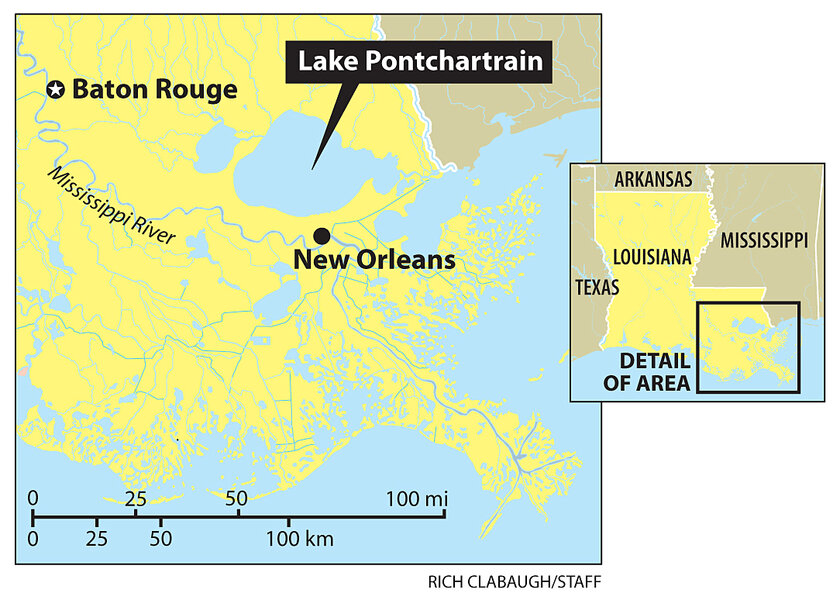Gulf oil spill's tar balls latest trouble for Lake Pontchartrain
Loading...
| New Orleans
Oil on New Orleans' back doorsteps became a possibility this week with news that tar balls had entered Lake Pontchartrain, the 600-square-mile inland body of water that for generations has been the city’s playground and proved to be its Achilles' heel during hurricane Katrina.
Fishing in the eastern waters of the lake was closed due to encroaching oil for the first time Monday, idling commercial fishers and crabbers, and sending hundreds of recreational fisherman back to their docks.
Tom Lopez, president of the Lake Pontchartrain Basin Foundation, first spotted oil entering the lake on Sunday through two passes, the Rigolets and Chef Mentur. Slipping past miles of boom and dozens of barges acting as oil barriers, the quarter- and nickel-size tar balls began washing onto shorelines and docks on Monday. Approximately 2,000 pounds of crude have been collected from the lake since Monday by containment workers using skim nets from small boats, says St. Tammany Parish president Kevin Davis.
Compared with the beaches and marshes stretching from central Louisiana to the Florida Panhandle that have been soiled with oil from the blown wellhead in the Gulf, the oil that has entered Lake Pontchartrain has so far been a minor skirmish in the region’s ongoing war with the spill. But the tar balls and oily sheens, blown in over the past few days by remnants of hurricane Alex and another low pressure system that formed just offshore in its wake, are causing worries about what an active tropical storm season could mean for the lake in coming months.
“Tropical weather will have an impact,” says Mr. Lopez. “The normal wind and current patterns don’t tend to push the oil right into the lake. It has to have these complex patterns we’ve seen over the past few days to do it. But once the oil gets close, the tides coming through the passes are very strong, and the currents will carry it right into the lake.”
Rough weather continues to keep skimmer boats in dock, says Mr. Davis, but the lake’s first lines of defense – including 39 stationary barges acting as solid boom, 10 miles of floating heavy boom, and 9,000 feet of newly installed stationary boom – helped keep additional oil out. Twenty-four skimmers have been docked due to choppy water, but a small armada of 50 other boats met the tar balls head on.
“If those get on shore, they will melt and dissolve and get back into the water, so we have to clean it up before that can happen,” Davis says. “We [are] keeping our fingers crossed that we have good weather and get the skimmer back, and hopefully the fishing closures can be lifted soon.”
While St. Tammany Parish enjoys the longest coastline on Lake Pontchartrain and has taken the lead with oil containment, neighboring Orleans Parish – home to New Orleans – has the longest history with the lake. The city was founded on its spot along the Mississippi River because the nearby lake offered an outlet into the Gulf of Mexico. In the first half of the 20th century, the southern shore of Lake Pontchartain became a playground for New Orleans, with beaches, lakeside restaurants, and an amusement park located adjacent to the spot where the campus of the University of New Orleans now stands.
By the 1970s, however, the lake was in crisis, its water quality plunging due to industrial clamshell dredging and wastewater runoff from bordering municipalities and farms. The lake started a comeback in the 1980s, beginning with the creation the Lake Pontchartrain Basin Foundation, a state-funded nonprofit that patterned itself after the Chesapeake Bay Foundation. Shell dredging and oil drilling on the lake were banned. Federal and state grants helped build new water treatment and sewage systems upstream.
“It was a dramatic turnabout, and the lake has continued to get healthier over the years,” says Lopez.
Fish stocks in the lake have rebounded over the past decade, with record trout caught this season in eastern portions of the lake that were closed to fishing this week, says Chris Schieble, a director of research for the University of New Orleans’ Pontchartrain Institute for Environmental Science. “It was one of the last bastions for fishing that hadn’t been closed yet because of the oil,” said Mr. Schieble, who studies the lake’s fish populations as director of the institute’s Nekton Laboratory. “Overall, the health of the lake keeps trending upward, but we keep having setbacks from what could be called catastrophic events.”
In 1998, hurricane Georges pushed large amounts of salt water into the lake, damaging plant and animal life. Hurricane Katrina did the same in 2005, then waste waters from New Orleans were pumped in by the US Army Corps of Engineers after the levee failures. The BP oil spill is just the latest challenge.
“If a large amount of oil gets into the lake now, that could be just as damaging as the clamshell dredging had been,” Schieble said. “The worst-case scenario could be a slow, weak hurricane or even a tropical storm coming in just west of the lake. It would push in a lot of oil, and in particular would cover all the marshes on the lake's east side with oil. That would be devastating.”
Related:






